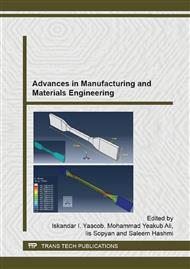p.292
p.296
p.300
p.304
p.308
p.317
p.321
p.325
p.331
A Light Material for Wind Turbine Blades
Abstract:
Nowadays, people have built mega-watt scales of wind turbines to generate electricity from wind energy. These big scales of wind turbine blade need lighter materials in order to optimize the generation of electricity. Due to this issue, purpose of this paper is to find a light material which is suitable to be used in making wind turbine blades. The use of natural fiber as a reinforcement agent in composite seems to have a big potential as natural fibers show desired characteristic needed for wind turbine blades' material. In this research, rice straw fiber was used as reinforced agent in composite with polypropylene as matrix. The composite produced was then characterized by mechanical testing which include tensile, flexural and impact as well as density measurement, dynamic mechanical testing (DMA) and Scanning Electron Microscopy (SEM). From the result obtained, it is found that the introduction of rice straw fiber to polypropylene matrix able improve the mechanical properties of the composite. The results of the composite obtained were then compared with current materials used.
Info:
Periodical:
Pages:
308-313
Citation:
Online since:
July 2015
Keywords:
Price:
Сopyright:
© 2015 Trans Tech Publications Ltd. All Rights Reserved
Share:
Citation:


